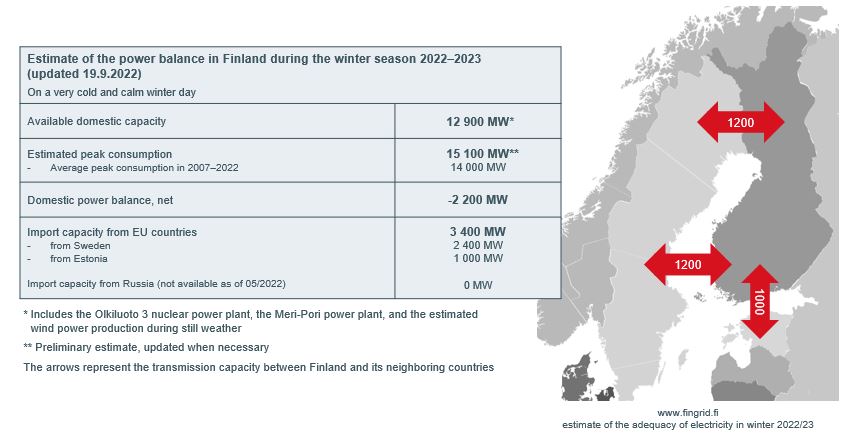Fingrid has updated its estimate of the adequacy of electricity in the coming winter: Changes in strategic reserve and the availability of imports
Fingrid has updated its estimate of the adequacy of electricity in the coming winter based on changes in the Energy Authority’s peak load reserve decision and the power balance in Southern Sweden. The situation is largely unchanged in other regards, as war continues to rage on European soil and the energy market remains in an extraordinary state, causing uncertainties around the availability of electricity. As a result of these great uncertainties, people in Finland should be prepared for power outages caused by possible electricity shortages this coming winter.
The power balance in Finland is the same in this updated assessment as it was in Fingrid’s first estimate, which was published on 22 August 2022. The Energy Authority decided to discontinue the procurement of strategic reserve, which was earlier estimated to offer a capacity of 600 megawatts. However, the available domestic supply on market terms is expected to increase correspondingly – by approximately 600 megawatts – as some of the power plants that were included in the previous peak load reserve season will now be put on the market. For example, Fortum has taken steps to prepare the Meri-Pori power plant for commercial operation.
Figure: Estimate of electricity production and consumption for the winter season 2022–2023 in a situation where the electricity system and market function without problems.
Reduced availability of imports from Southern Finland – Every Finn can affect the amount of electricity consumed
One significant factor affecting the adequacy of electricity is the availability of imported electricity, as Finland has imported substantial amounts of electricity from Sweden and Estonia during times of peak consumption. The availability of imports from Southern Sweden was impacted by the announcement of a delay in the maintenance of the Ringhals 4 nuclear power plant, keeping it offline until the end of January. Consequently, the Swedish transmission system operator, Svenska kraftnät, has warned of an elevated risk of power cuts in Southern Sweden.
In peak consumption situations, the normal operation of the electricity market and demand-side management when prices are high help the system operation. Simultaneous disturbances at significant electricity generation facilities or in electricity transmission connections can pose challenges to the adequacy of electricity. A severe frost period, which simultaneously affects Finland and other countries in the Baltic Sea region, causes a particularly challenging situation. In such cases, electricity consumption is high, and the availability of electricity imports can be jeopardised.
Every electricity consumer in Finland can affect the amount of electricity that is needed. Finland is most dependent on imported electricity during consumption peaks – typically on weekday mornings and early evenings. If we reduce our electricity consumption during the expensive peak hours and consume electricity at night instead, we can reduce the need for imported electricity, thereby decreasing the risk of an electricity shortage. For example, a five-per-cent decrease in peak consumption would translate to approximately 700 megawatts. See the article in the Fingrid magazine (in Finnish) for more information on how to avoid the electricity rush hours in the mornings and early evenings.
Fingrid will update its estimate of the adequacy of electricity for the coming winter as the situational picture changes.
Further information:
Tuomas Rauhala, Senior Vice President, Fingrid Oyj, tel. +358 40 506 4695
Fingrid's bulletin 22 August, 2022 >
Energy Authority's bulletin 16 August, 2022 > (in Finnish)
Fortum's bulletin 16 august, 2022 > (in Finnish)
Information about electricity shortages and how they are handled >
Fact box: Key factors affecting the adequacy of electricity
- In the coming winter, the weather will have a major impact on peak consumption and the wind power production. The actual peak consumption is lower if the weather is mild, and wind power production is higher in times of windy weather.
- Generating capacity of power plants. Generating capacity may be affected by failures or a delay in the commissioning of the Olkiluoto 3 nuclear power plant, as well as problems in the availability of power plant fuels, especially natural gas.
- The reliability of transmission connections to ensure import capacity. The availability of imports may also be affected by internal problems with the adequacy of electricity in the exporting countries.

